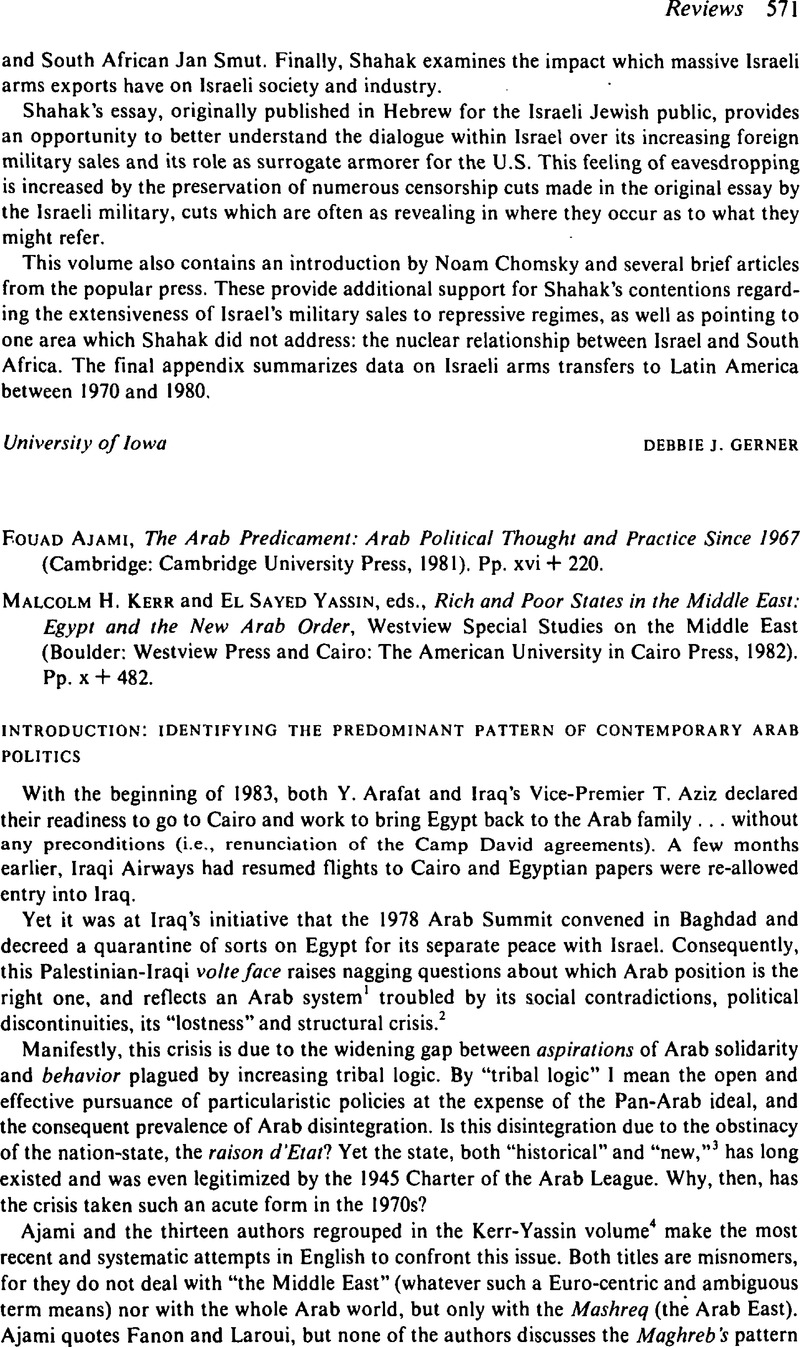Article contents
Fouad Ajami, The Arab Predicament: Arab Political Thought and Practice Since 1967 (Cambridge: Cambridge University Press, 1981). Pp. xvi + 220. - Malcolm H. Kerr and El Sayed Yassin, eds., Rich and Poor States in the Middle East: Egypt and the New Arab Order, Westview Special Studies on the Middle East (Boulder: Westview Press and Cairo: The American University in Cairo Press, 1982). Pp. x + 482.
Published online by Cambridge University Press: 29 January 2009
Abstract

- Type
- Book Reviews
- Information
- Copyright
- Copyright © Cambridge University Press 1983
References
NOTES
1 The concept of “system” as used in the social sciences does not necessarily imply harmony, cooperation, or even institutions. The emphasis is rather on a regular pattern of interaction among the members of a set, and the presence of explicit or implicit rules. It is in this sense that historians and politicians talk about “the balance of power system.” It is in a similar sense that Saad Ibrahim uses the word “order” which“… should not imply ‘orderliness,’ ‘congruency,’ or ‘harmony’…” He emphasizes that “… its elements are linked to and affect one another…” as part of a “constant internal motion” which might not always be noticed by outsiders; see Ibrahim, Saad E., The New Arab Social Order (Boulder: Westview Press, 1982, pp. 13–20).Google Scholar For us, order is not exactly interchangeable with system, because a certain order can characterise a specific phase in the life of a system: e.g., new versus old, bipolar versus multipolar. The most useful introduction to the concept in International Relations is Braillard, Philippe, Théorie des Systèmes es Relations Internationales (Brussels: Bruylant, 1977).Google Scholar For a recent and compact application of the system concept to the evolution of the Arab world in the 1970s, see Noble, Paul, “The Arab System: Opportunities, Constraints and Pressures” in Korany, Bahgat & Dessouki, Ali E. H., eds., The Foreign Policies of Arab States (Boulder: Westview Press, 1983).Google Scholar
2 Did not the Palestinian leader Shafik El-Hout lament, before the 15th Annual Convention of Arab-American University Graduates (Montreal, October 1982), that during the 1982 Israeli invasion of Lebanon, anti-war demonstrations within Israel were greater in number than those within the whole Arab World?Google Scholar
3 In a press interview with the Israeli journalist Amos Elan, Ambassador Tahseen Bashir—Egypt's last ‘permanent’ delegate to the Arab League—expressed the difference in a categorical and daring way: “You see, my dear Amos, when the chips are down, there is only one real place in this entire area. Egypt. All the rest—forgive me—are tribes with flags” (New York Times Magazine, 12 October 1980, p. 84). Nevertheless, President Sadat's “sacred mission” to Israel is a prime example of tribal logic—in the sense used in this article.Google Scholar
4 In addition to Kerr's introductory and concluding chapters, the eleven chapters are divided as follows: four on Egypt (G. Abdel-Khalek on the economy, G. Amin on Egypt's historical dependency, N. Ayubi on the political dimension of the Infitah, and G. Sabagh on migration and social mobility in Egypt); two chapters on more than one state and their interactions (H. El-Beblawi on the Gulf oil states, N. El-Sherbiny and I. Serageddine on Saudi demand and Egyptian labor); and the remaining five concentrate explicitly on “macro” or regional aspects (A. Dessouki, S. Ibrahim, and E. Montasser deal, respectively, with the political, social, and economic dimensions of the New Arab Order; P. Jabber deals with the Riyadh-Cairo axis and regional diplomacy, and J. Salacuse concentrates on Arab capital and trilateral ventures).Google Scholar
5 In a recent and pioneering study of the History of Arab Economic Thought (Beirut: Center for Arab Unity Studies, 1982 [Arabic), Mahmoud Abdel-Fadil has avoided this lopsidedness.Google Scholar
6 For instance, see Ibrahim's previously cited book, footnote 1.Google Scholar
7 Most recent data on this issue are included in: Diskin, Abraham and Mishal, Shaul, “Spatial Models and Centrality of International Communities,” Journal of Conflict Resolution, 25, 4 (12 1981), 655–76;Google ScholarThompson, William R., “Delineating Regional Subsystems,” International Journal of Middle East Studies, 13, 3 (05 1981), 213–35;CrossRefGoogle ScholarThompson, William R., “Center-Periphery Interaction Patterns,” International Organization.Google Scholar
8 For a more detailed analysis of the fragility, dependence, and the family dimension of the petrostate, see Korany, Bahgat, “Allah's Wish? Premises and Promises of Arab Political Economy,” paper presented to the South-South Conference: Strategies of Cooperation, Development and Negotiations, Chinese Academy of the Social Sciences, Beijing, April 1983.Google Scholar
9 Ayubi, Nazih N. M., “Vulnerability of the Rich,” paper prepared for the Gulf Project, Center for Strategic and International Studies, Georgetown University, Washington D.C., 06 1982, pp. 2–3.Google Scholar
10 Fadil, Mahmoud Abdel, Oil and Arab Unity (Beirut: Center for Arab Unity Studies, 1979) (in Arabic).Google Scholar
11 Gottheil, Fred M. as quoted in Ayubi, “Vulnerability of the Rich,” p. 50.Google Scholar
12 Gilani, Ijaz, “Pragmatic Arabism: The Logic of Contemporary Inter-Arab Relations,” unpublished Ph.D. thesis, Department of Political Science, Massachussetts Institute of Technology, 1977;Google Scholar and more recently, Khoury, Nabeel A., “The Pragmatic Trend in Inter-Arab Politics,” Middle East Journal, 36, 3 (Summer 1982), 374–387.Google Scholar
13 Some other notable examples of dealing with Arab future are Amin, Samir, La nation arabe (Paris: Editions de Minuit, 1976), pp. 139–153);Google Scholar and Saadeddine, Ibrahim et al. , Portraits of the Arab Future (Beirut: Center for Arab Unity Studies and United Nations University, 1982) (in Arabic).Google Scholar
14 Yet Kerr himself has dealt with this area in his “Political and Economic Trends in North Africa” in Udovitch, A. L., ed., The Middle East: Oil, Conflict and Hope (Lexington, Mass.: Lexington Books, 1976), pp. 383–426.Google Scholar
- 1
- Cited by




